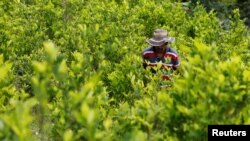Colombia's acreage of coca, the raw material for cocaine, expanded 17 percent to hit a new record last year, the United Nations said on Wednesday, as the government mulls whether to restart aerial fumigation with the herbicide glyphosate.
The total area of the Andean nation under coca cultivation increased to 171,000 hectares (422,550 acres) by the end of 2017, according to the United Nations Office on Drugs and Crime, due to increased productivity and growers’ eager to expand in the hope of getting more aid to switch to legal crops.
The figure is the largest since the U.N. began keeping records, it said, adding that potential cocaine production was 1,379 metric tons last year.
Colombia has long been ranked as the world's top producer of cocaine. In June, a U.S. government report said its potential cocaine output had risen to 921 metric tons in 2017.
President Ivan Duque, who took office last month, has said aerial fumigation with glyphosate could be restarted if the effort complies with conditions laid out by the country's Constitutional Court.
Use of the herbicide was suspended by previous President Juan Manuel Santos in 2015 after the World Health Organization linked it to cancer.
In June, Santos authorized the use of glyphosate in fumigations using drones, saying they fly low enough to limit dangers associated with the herbicide.
But the Constitutional Court has said studies must be conducted on glyphosate and strict regulations put on its use, among other conditions, if spraying is to resume.
Duque said on Wednesday the government would implement a new strategy to fight drug trafficking soon.
"Our goal in the next four years is to have concrete results," he told journalists. "So we can at least eradicate more than 70 percent of what we have today."
Glyphosate is a key ingredient in the world's most widely-used herbicide, Roundup, produced by Bayer AG's Monsanto unit. Bayer denies allegations that glyphosate causes cancer.
Colombia has been plagued by violence associated with the drug trade for decades. Rebel groups, right-wing paramilitaries and armed gangs make billions of dollars moving cocaine overseas.
The government signed a peace accord in late 2016 with the Marxist Revolutionary Armed Forces of Colombia (FARC) guerrilla group, which was heavily involved in coca production. But new armed groups are now fighting over lucrative growing and trafficking routes.
Between 2000 and 2015, the United States, the main destination for Colombian cocaine, gave the country some $10 billion to fight drug trafficking. U.S. aid now stands at about $400 million annually.





